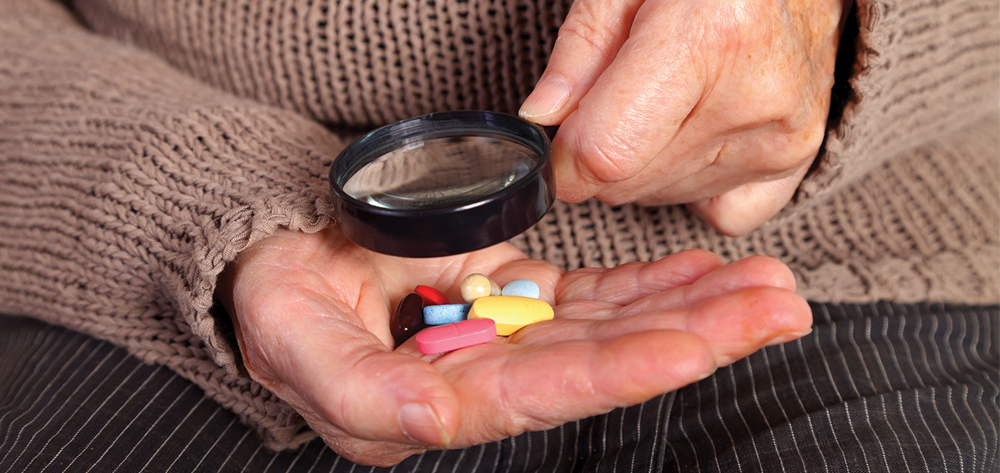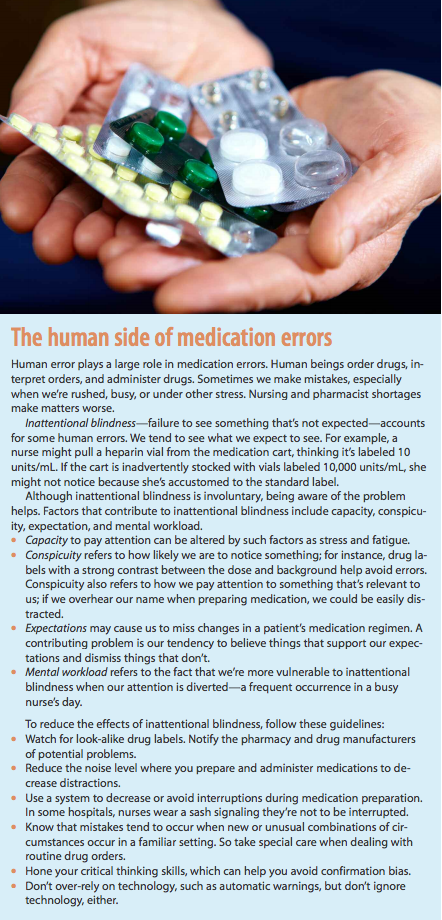Preventable medication errors cost the U.S. healthcare system more than $21 billion annually, according to the National Priorities Partnership and National Quality Forum. This number has risen significantly since the Institute of Medicine published To Err Is Human: Building a Safer Health System in 1999. That report suggested medication errors cause more deaths in 1 year than motor vehicles, breast cancer, and AIDS. The National Priorities Partnership and National Quality Forum report estimated that 98,000 people die each year from hospital-related medication errors and other medical errors, at a cost of $17 to $29 billion. Follow-up studies found more and more people are being treated outside the hospital and the number of preventable errors is rising, despite the many measures taken to prevent them. Why do such errors still occur? What can be done to address their causes and prevent more errors?
To Err Is Human led to initiatives to help prevent medication errors. Since then, researchers have found that many of the problems leading to these errors are systemic and cultural. Consequently, they recommend a multipronged approach to error prevention. In 1999, the Agency for Healthcare Research and Quality began to focus heavily on preventing medication errors. Many more studies have been done and possible solutions have been implemented, but recent reports show that an increasing number of errors are endangering patients and costing the healthcare system billions of dollars.
The nursing profession has been at the forefront of preventing medication errors. For nurses, these errors can occur if they fail to ensure the “five rights” of drug administration—right patient, right drug, right dosage, right route, and right time.
A simple checklist is no longer enough
Times have changed, and we need more than just a simple checklist like the “five rights” to keep patients safe. The “five rights” were established when multiple drugs or potentially dangerous drugs were given mostly to hospital patients. Back then, the checks-and-balances system usually worked effectively: The prescriber, pharmacist, and nurse each checked the drug before it was given to the patient. If the prescriber made an error, the pharmacist was likely to catch it. If the error got by the pharmacist or if the pharmacist made an error, the bedside nurse was likely to discover it before the patient received the drug.
But over the last few decades, hospital stays have shortened drastically and limits have been put on drug spending. Surgeries that used to require a week’s stay with nursing care and medication teaching now fall under the 23-hour rule of hospitalization, which allows only 23 hours of hospitalization for various types of surgery. After just the briefest hospital stay, patients must go home and manage their own medications—and many of their regimens involve multiple drugs.
Now that most patients manage their regimens as outpatients, the patient has become a crucial member of the healthcare team. The “five rights” and other traditional checks and balances are no longer adequate because they don’t include the patient.
An overwhelming challenge
Patients left to manage their own regimens face what for some might seem an overwhelming challenge. Many turn to the Internet for help—but not all websites are reliable or up-to-date. Based on what they read online, some people may change their drug regimen on their own or decide not to take prescribed medications. Or they may replace them with complementary and alternative medicines (CAMs), which aren’t regulated by the Food and Drug Administration (FDA) and aren’t necessarily safe or effective. What’s more, many CAMs interact dangerously with prescription drugs. When asked by healthcare providers what drugs and supplements they’re taking, many patients don’t reveal they’re using these products.
In addition, the number of available over-the-counter (OTC) drugs grows every year. These products are safe when used as directed—but how many people follow the directions? Also, many OTC drugs interact with prescription medications and, as with CAMs, patients may not tell healthcare providers they’re using them.
People are traveling more than ever, too, increasing their chance of contracting diseases abroad, where they may experience medication errors because drug names aren’t consistent from one country to the next. For instance, in the United States, Ambien is the brand name of zolpidem, a sleeping aid; in the United Kingdom, Ambyn is the brand name of amiodarone, a potent antiarrhythmic. People who travel abroad need to know the generic names—not just the brand names—of all drugs they’re taking.
Steps in the right direction
So what can government agencies, private organizations, and other stakeholders do to decrease medication errors? Working with the pharmaceutical industry and healthcare organizations, the FDA has implemented systemic changes to help prevent medication errors.
Look-alike and sound-alike drug names
Drugs names that look or sound alike have led to many errors. Today, the FDA screens medication brand names carefully and, in some cases, mandates a change in a name to prevent similarities than can confuse clinicians and patients. One example is omega-3-acid ethyl esters. This lipid-regulating drug originally was sold under the brand name Omacor. But prescribing and dispensing errors occurred because Omacor is similar to Amicar (aminocaproic acid), used to treat certain bleeding disorders. In 2007, the brand name Omacor was changed to Lovaza to help avoid confusion.
What’s more, on pharmacy shelves, drugs typically are arranged alphabetically. Errors have occurred when healthcare workers mistakenly picked up the wrong bottle. To help prevent these errors, labels and colors have been changed on some drug packaging, and TALLman letters are used to help differentiate look-alike drug names. Examples of TALLman lettering include:
- DOPamine vs. DOBUtamine
- DOXOrubicin vs. DAUNOrubicin
- sulfADIAZINE vs. sulfiSOXAZOLE.
Barcode scanning and OTC drug labeling
Electronic drug ordering has helped prevent many errors, but errors still occur when drugs on the list are similar and the wrong drug is chosen. To prevent mix-ups, many hospitals now use barcode scanners to match the patient with the correct drug.
OTC drug labeling also has been changed so consumers can more easily see the drug’s active ingredients, dosing instructions, and precautions.
Error-prone abbreviations and other preventive measures
In 2002, The Joint Commission (TJC) established a National Patient Safety Goal requiring accredited healthcare organizations to develop and implement a list of abbreviations not to use. In 2004, it created its own “Do not use” list of abbreviations. The Institute for Safe Medication Practices (ISMP) also has a list of error-prone abbreviations, symbols, and dose designations. (See https://www.ismp.org/tools/errorproneabbreviations.pdf.)
Other strategies to reduce medication errors include using independent double-checks of drugs before administration, encouraging prescribers to print instead of write prescriptions, improving staffing, and—perhaps most important—educating healthcare providers at all levels to work toward preventing errors. (See The human side of medication errors.)
Updating the five rights
To make the “five rights” more relevant to today’s healthcare environment, we need to think of these rights in a new way.
The right patient no longer means simply that the patient’s name matches the name on the prescription. Nurses also have to ensure that:
- the patient isn’t taking other prescriptions, CAMs, OTC drugs, herbal products, vitamins, minerals, or foods that could interact with the prescribed drug
- the specific drug and dosage make sense for this patient
- the patient’s pregnancy status has been assessed the patient doesn’t have allergies that could cause a problem with the prescribed drug.
The right drug no longer means only what the provider prescribed. Also consider whether:
- this drug is appropriate for this patient
- the drug could interact with other drugs the patient is taking
- it requires dietary restrictions
- it’s a high-risk drug that requires extra monitoring
- the generic and brand names match those on the prescription.
The right dose (which these days may be determined by a computer) needs to match the patient’s specific situation. Ask yourself:
- Does the patient have a condition that might require dosage modification?
- Does the patient need to take only two or three units of the medication?
- Does the ordered dosage make sense for this patient?
- Is there a “naked” decimal point that changes the meaning of the prescription?
The right route also needs to be assessed with the specific patient in mind. Ask yourself:
- For an oral drug, can the patient swallow the dose (without cutting or crushing a medication that shouldn’t be cut or crushed)?
- For an inhaler drug, can the patient operate the inhaler properly?
- For an injected drug, can the patient prepare and self-administer the injection?
The right time has always been an elusive goal in nursing. Things can and do happen that prevent exact timing of medication administration. Yet in some cases, timing is crucial for determining the critical concentration and safety of a drug. Ensuring the correct time for drug administration requires knowledge of the prescribed drug and the patient who will receive it.
In a hospital or other healthcare facility, mastering these updated “five rights” to ensure patient safety is possible. But when the patient goes home and must manage the drug regimen without nursing guidance, serious obstacles may arise.
Educating and empowering patients
Although we continue to change or improve systems and implement policies to reduce medication errors, these may fail unless we put the patient at the center of the effort. The latest summary of reported medication errors (“Preventing Medication Errors: A $21 Billion Opportunity,” from the National Priorities Partnership and National Quality Forum) showed that the largest contributor to medication errors is the prescriber’s lack of knowledge about other drugs and preparations the patient’s taking, which can lead to serious interactions or overdose. Only the patient has this key information required to prevent medication errors. Only the patient knows which prescribed drugs, OTC preparations, and CAMs he or she is taking and how and when these are taken.
All the more reason for us to educate patients about the medications and other products they’re using, and empower them to speak up about their medications to healthcare providers, including whether they’re actually taking them and how often. Encourage patients to speak up so they can protect themselves from errors. Inform them that they are key healthcare team members. Instruct them to keep a list of all drugs they’re actually taking and urge them to feel empowered to show it to every healthcare provider they see.
With today’s short hospital stays and increased emphasis on outpatient care, providing comprehensive medication education to patients can be a daunting task. For a concise list of key topics to include when teaching patients about their medications, see Key patient teaching points.
When patients manage their drug regimens at home, the potential for medication errors is enormous. To help them avoid errors, be sure to review actual and potential problems with patients and educate them on ways to stay safe. The best way to reduce medication errors is to teach patients about their medications and encourage them to speak up and become key members of their healthcare team.
Selected references
Food and Drug Administration. Medication Errors. Last updated May 21, 2015. http://www.fda20.gov/drugs/drugsafety/medicationerrors/default.htm
Institute for Safe Medication Practices. ISMP’s List of Error-Prone Abbreviations, Symbols, and Dose Designations. 2013. https://www.ismp.org/tools/errorproneabbreviations.pdf
Institute for Safe Medication Practices. Part 1: Results of the pediatric medication safety initiative: More is needed to protect hospitalized children from medication errors. June 4, 2015. www.ismp.org/newsletters/acutecare/showarticle.aspx?id=110
Institute for Safe Medication Practices. Results of pediatric medication safety survey (Part 2): Comparing data subsets points out areas for improvement. July 2, 2015. www.ismp.org/newsletters/acutecare/showarticle.aspx?id=112
Institute of Medicine. To Err Is Human: Building a Safer Health System. Washington, DC: National Academies Press; 1999.
Joint Commission, The. Ambulatory Care National Patient Safety Goals; 2015. www.jointcommission.org/assets/1/6/2015_AHC_NPSG_ER.pdf
Jones JH, Treiber L. When the 5 rights go wrong: medication errors from the nursing perspective. J Nurs Care Qual. 2010;25(3): 240-7.
Kaushal R, Kern LM, Barrón Y, Quaresimo J, Abramson EL. Electronic prescribing improves medication safety in community-based office practices. J Gen Intern Med. 2010;25(6):530-6.
Kuehn BM. FDA initiative aims to reduce medication-related errors. JAMA. 2009;
302(21):2304.
Lewis TP, Smith CB, Williams-Jones P. Tips to reduce dangerous interruptions by healthcare staff. Nursing. 2012;42(11):65-7.
National Priorities Partnership and National Quality Forum. Preventing Medication Errors: A $21 Billion Opportunity. December 2010. www.nehi.net/bendthecurve/sup/documents/Medication_Errors_%20Brief.pdf
New England Healthcare Institute. How Many More Studies Will It Take? A Collection of Evidence That Our Health Care System Can Do Better. 2008. http://www.nehi.net/writable/publication_files/file/how_many_more_studies_will_it_take_introduction.pdf
Nurses Service Organization. How did I make that mistake? NSO Risk Advisor. 2013. www.nso.com/Documents/pdfs/Newsletters/NSO2013_RN_Online_FINAL.pdf
Spath PL. Error Reduction in Health Care: A Systems Approach to Improving Patient Safety. 2nd ed. San Francisco: Jossey-Bass; 2011.
Weingart SN, Simchowitz B, Padolsky H, et al. An empirical model to estimate the potential impact of medication safety alerts on patient safety, health care utilization, and cost in ambulatory care. Arch Intern Med. 2009;169(16):1465-73.
Amy M. Karch is an associate professor of clinical nursing at the University of Rochester School of Nursing in Rochester, New York.



















